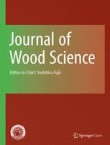
Photo from archive.org
The aim of this work was to investigate the structure–property relationships of two different monocotyledon trunks: bamboo (Bambusa blumeana Schultes) and oil palm (Elaeis guineensis Jacq). Anatomical characteristics (fraction of… Click to show full abstract
The aim of this work was to investigate the structure–property relationships of two different monocotyledon trunks: bamboo (Bambusa blumeana Schultes) and oil palm (Elaeis guineensis Jacq). Anatomical characteristics (fraction of fibers) and physical (density, water uptake, and swelling in the radial direction) and mechanical (modulus of rupture and modulus of elasticity) properties of bamboo and oil palm trunks were examined. The results showed that the examined properties of both species were mainly governed by fibers. Those of bamboo were mostly greater. Functions relating most of the examined properties to the density of both species were finally achieved. Based on the results obtained, it is suggested that bamboo has a higher potential for structural application, while oil palm wood is more likely to be utilized for non-structural purposes.
Journal Title: Journal of Wood Science
Year Published: 2017
Link to full text (if available)
Share on Social Media: Sign Up to like & get
recommendations!